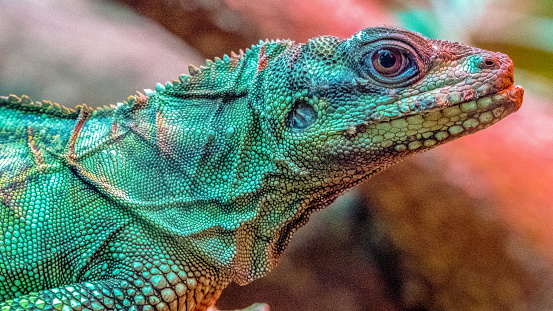ANIMAL: Weber’s Sailfin Lizard/Dragon Hydrosaurus weberi Type of Animal: Agamid Habitat: Rivers, mangroves, coastal marshes, riverside forests, tree branches along waterway banks, forested river edges, swamps Location(s): Moluccan islands of Halmahera & Ternate Appearance: Smallest sailfin lizard/dragon species, greenish in coloration darkening w/ age, males larger than females, big eyes, short snout, long tail, males have much larger crests/sails, some males have blunt scaly horn on top of nose, males more colorful than females, females lighter than males, has longest tail of all sailfin lizards/dragons Food/Diet: Insects, insect larvae, snails, fruit, berries, greens, vegetables, vegetation, legumes, flowers, mice, shrimp, crayfish, fish, earthworms, crabs, spiders, grains, eggs Status in Wild: Threatened Conservation: Breeding in zoos, wildlife centers, & private breeders Lifestyle: Solitary Additional Info: Called: Male Female Young: Hatchling Group: Solitary Weight: Male: 2.5-3 lbs Female: 1-2 lbs Young: 0.5 lb Gestation: 2 months Life Span: 15-20 years Body Length: Male: 3 ft Female: 2 ft Young: 0.7 ft Tail Length: Male: 2 ft Female: 1.5 ft Main predators of adults are dogs, cats, & large raptors. Many birds, snakes, & large fish prey on young. Threatened due to pet trade, water pollution, habitat loss, & hunting for meat. Sexually mature at 2 years old. They’re very fast lizards. Sail on males plays important role in territorial displays & for attracting females. Also plays heating/cooling role. Females lay multiple clutches of 2-8 eggs every year. Use tails to push themselves along in water. They spend lots of time in trees. Active during the day (diurnal). Males extremely territorial, sometimes fighting to the death. Females may fight fiercely as well. These lizards are shy in the wild. Fun Fact(s): These lizards are not for novice pet owners. Captive individuals often poop/drink/swim in same water pan, meaning daily water change. These lizards can hide underwater for over an hour. Flee at 1st sight of danger, usually running bipedally into water until sinking/swimming away. 1st part of scientific name (Hydrosaurus) means water lizard & they’re excellent swimmers never found far from water. Named after German-Dutch zoologist/biogeographer Max Weber (not to be confused w/ German sociologist Max Weber). They can be very flighty & wild-caught individuals often never tame down. Hand-raised individuals, however, can become very tame.
